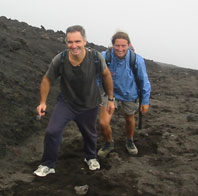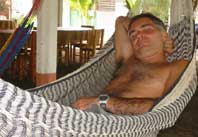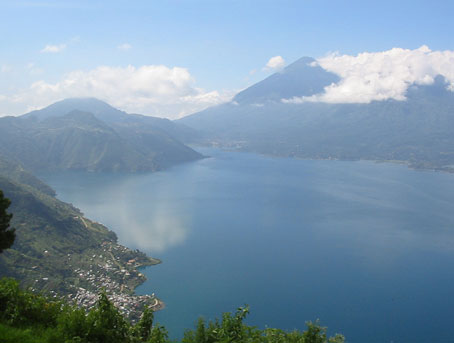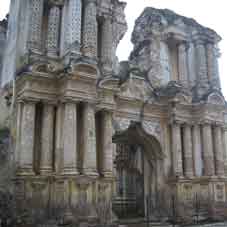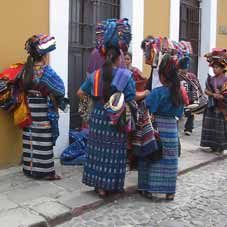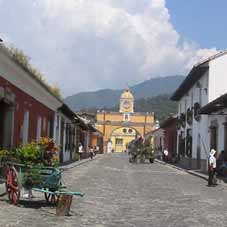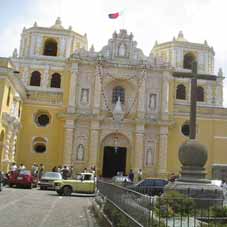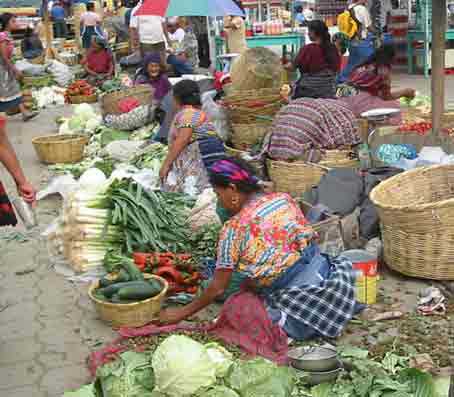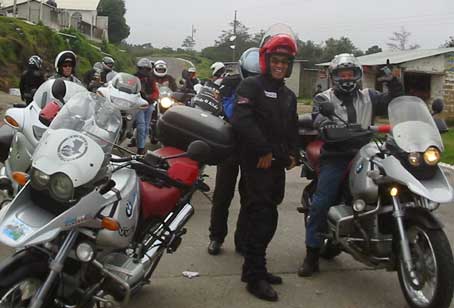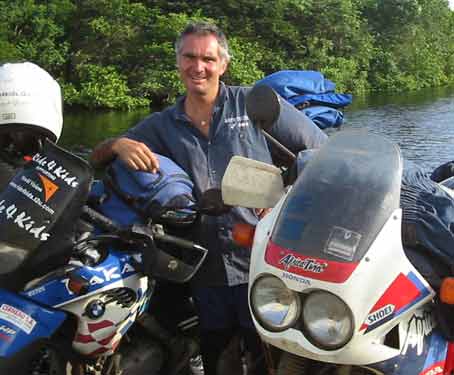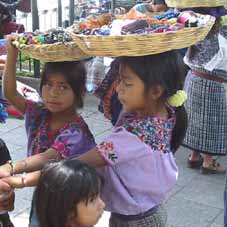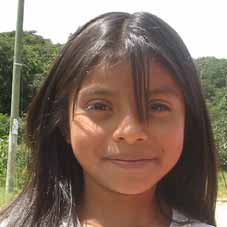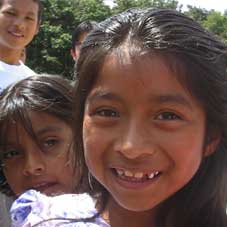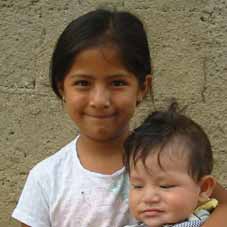The heart
of the Mayan world.
From
conquistadores and earthquakes to death squads and guerrilla cadres, Guatemala
has been locked in a centuries-long struggle for tranquillity and equality.
However, with its tragic history and modern difficulties, Guatemala remains
a fascinating land, its paradoxes fuelling its air of inscrutability.
Consisting primary of mountainous forest highlands and jungle plains, Guatemala
covers an area of 109,000 sq km. The western highlands, where I spent most of
my time, hold 30 volcanoes reaching heights of 3800m. The land is covered in
pine forests, though these are dwindling rapidly.
Guatemala has a population of around 13 million habitants, with 56% as mestizo
and 44% as indigenous. The population is due to double by the year 2020 if it
continues to grow at its current rate of 2.68% annually.
Coffee is the biggest export crop, followed by sugar, cotton, bananas and cardamom.
Roman Catholicism is Guatemala's predominant religion but not the only one.
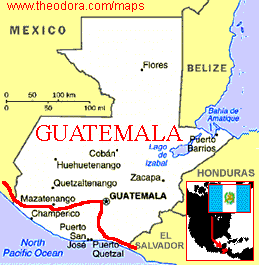
Saturday,
4 October 2003.
I had spent the night only meters from the border and I was quietly confident
that the crossing would be a piece of cake. I joined the queue at 7.00am, had
my passport stamped out of Mexico in no time but when I met with the Mexican
custom I was told that I would have to go back to Tapachula (30km) in order
to have my import permit cancelled (they keep your credit card number as a guaranty).
I had to do it otherwise they would think that my vehicle was still in Mexico
and they would take out money
from
my credit card to cover the import taxes. Obviously I was not very happy about
that and to make things worse it started to rain as I was riding back. I arrived
soaking wet and found out that been a Saturday it would open only at 9am, it
was 8. Eventually things got better, the sun came out, I dried out and was able
to cancel everything. Back at the border I had to do everything over again with
the Guatemalan custom. This time no credit card was needed and I only had to
pay US$7 for the paper work. They also insisted on spraying my bike on order
to disinfect it against the bacterids from Mexico. It doesn't make any sense
as there is nothing to stop the birds or the flies to cross the border and carry
the diseases. Also they only sprayed the lower part of the bike and not the
top. Another US$2 was required for this little exercise. It was 11 o'clock by
the time I was ready to get back on the road.
I was heading to the small town of Panajachel on the shore of Lago de Atitlán
some 300 Km further south. This is the most dramatic region of Guatemala. Along
the way I was spoiled with beautiful sceneries and the weather was mostly fine
apart from a cold shower on the highland just before arriving at my destination.
The verdant hills were covered of emerald green grass, cornfields and towering
stand of pine. Along the road I could see men, women and children carrying burdens
of firewood on their backs, to be used for heating and cooking. I had visited
this region twice before and I was still excited to return once again to this
amazing place. Lago Atitlán is a collapsed volcanic cone filled with
shimmering waters to a maximum depth of more than 320m and covering 128 sq km.
It is surrounded by three powerful volcanoes; the highest is volcán Atitlán
at 3537m.
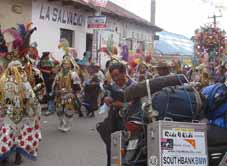
That
day was Panajachel annual festival and I was surrounded by hundreds of
colourful people as I was making my way to a place to stay. The town was really
alive with music, streets vendors and firecrackers. A religious procession was
also trying to make its way to the main church. I found a cheap guesthouse to
stay and spent the following few days exploring the region.
My next destination was Antigua de Guatemala
(pop.30,000), one of the oldest and most beautiful cities in the Americas.
Its majestic setting, cobblestone streets, crumbling ruins and sprays of Bougainvillea
(my favourite tree) bursting from terra cotta roofs is most charming. It was
founded in 1543 and served as the colonial capital for 233 years but was completely
destroyed by an earthquake in 1773. The town was then slowly rebuilt, retaining
its traditional character, architecture and cobblestone streets. In 1979,
Unesco declared it a World Heritage Site.
I arrived in Antigua in mid-morning and met Ariel, a very friendly
local biker owner of a BMW GS1150 and also an avid traveller. Ariel told me
that he had travelled from Alaska to Argentina on his bike. He invited me
to join the Guatemala BMW Club on the following Friday for breakfast and a
ride. In the meantime I found an adequate place to stay in the centre of town
and decided to make Antigua my base for Guatemala. At the guesthouse I met
Albert Hoermann, an Austrian guy travelling also on a motorbike (Africa
Twin), his plan was to travel from Mexico to Costa Rica.
The next day I went to Guatemala City to visit the National World Vision
office in order to make some arrangement to visit a project.
Guatemala city, the capital (pop 2 million), is the largest urban agglomeration
in Central America and spreads across a flattened mountain range run through
by deep ravines. Its huge chaotic market burst with dazzling smells, sounds
and colours. Rickety buses chug along in clouds of diesel, trolling for ever
more passengers, and street urchins eke out a tenuous existence in the city's
poverty- stricken outlying areas. Earthquake in 1917, 1918 and 1976 rocked
it, reducing buildings to rubble. The 1976 quake killed nearly 23,000 people,
injured another 75,000 and left an estimated one million homeless. Guatemala
City is also a dangerous place and has seen armed robbery, purse-snatching
and carjacking and it is not safe to wander around at night. This is why I
preferred to make Antigua my base as it is only 45 Km away.
Friday, 10 October.
As planned I met the BMW Club at 7.30am at the best hotel in town and was
offered a full buffet breakfast free of charge by Arne Snapper (owner
of the Bavaria Motors and also the importer of BMW since 1958). Around
14 members were already there, all of them riding very big bikes, mostly GS
1150. After meeting everyone, and of course making a pig of myself with all
the beautiful food, we set out to Panajachel again but this time on a very
scenic course, only known to them. It was a beautiful morning, all the volcanoes
around were clear and the sun had decided to join us. We stopped along the
way to take some photos and to listen to Randy, an American who came along
to give everyone riding instruction on safety (Randy works for BMW as a riding
instructor). We reached Panajachel by lunch time and headed straight to the
best hotel in town (nothing but the best for those guys). Again I was treated
to a beautiful buffet
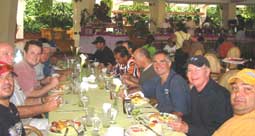
lunch and had to stop myself from overloading
my plate but made sure to return a few times to the buffet..
The boys were in good shape for the trip back home and I had to work hard to
keep up with them. We left each others on the promise that I would do a presentation
of Ride4kids the following Monday at the
BMW
headquarters in Guatemala City (as the saying goes, there is nothing as a free
lunch).
A couple of day later I decided to climb Pacaya, an active volcano near
Antigua but sleeping at the moment. I was joined by Albert and we left at 7am.
It was only 50 Km away. We parked the bikes near the police post and started
the climb. Because Pacaya
attracts tourists it also attracts bandits so
it is wise to be accompanied by a security guard but we did not as we saw other
climbers around. I still reckoned that travellers are more likely to get hurt
by flaming rocks and sulphurous fog than criminals. It took us around one hour
and half to reach the summit, it was cloudy at time and the visibility was not
the best. The only thing coming out was smoke and sulphurous gas. I had climbed
Pacaya 10 years ago when it was in eruption, even though I was not able to get
close to the summit that time it was much more interesting than this time.
Nevertheless
we had a great morning and returned to Antigua early in the afternoon.
On Monday night I rode to Guatemala City to do my presentation, Albert came
along as well. I was a little disappointed of the turn out due to the short
notice and of the choice of day (Monday). Nonetheless everyone seemed to enjoy
the show and the night was concluded with complimentary refreshments by Mr Arne
Sapper.
Wednesday, 15 October.
I rode early to Guatemala City as I had an appointment with Daphne De Araneda
at the World Vision National Office.
World Vision Guatemala, which begun in 1975, has three main work areas:
- Transformational Development which is based on the community, with
special attention on children. It is an integration of efforts. Its main goal
is to produce changes and transformation on the physical, spiritual, social,
cultural and ecological conditions in the people in poverty.
- Prevention, Emergency and Rehabilitation of Disasters. Guatemala is
highly vulnerable to natural disasters and to disasters cause by humans, this
is why PER is one of the main work lines. World Vision Guatemala has given supports
to affected families during emergency situations in the past. These types of
emergencies have increased in the past years with Hurricane Mitch and Niño
and Niña phenomena's.
- Advocacy. World Vision Guatemala has developed a Children's Advocacy
program. It promotes actions for their well being in equity conditions. This
program helps prepare children to face the world where challenges are harder
every day.
Guatemala has over 50 thousand sponsored children
and most of the projects are funded by the United States as well as Australia
and Canada.
I must admit that I was a little disappointed with my visit. For some reason
I was not able to visit an ADP somewhere near the El Salvador border but instead
Daphne took me to a small community close to the capital. There, I met around
25 sponsored children who were taking part in a program conducted by older
children. All the younger children were sitting around while five teenagers
talked to them about the value of good nutrition. They had a few games which
I was asked to join in with them.
Then we went to visit a family living near by which was involved in a program
called Hocasos. The sustainable peasant homes program promotes actions to
improve the life quality of a family. I got to speak to the 7 years old daughter
and was able to find out a little about her every day life, for example what
she eats for breakfast and how far she has to walk to attend school. And that
was the end of my visit, by one o'clock I was back in the capital. As I said,
I was a little disenchanted with my visit as I expected to see much more.
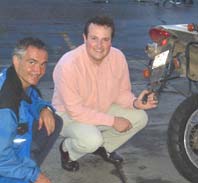
I
had arranged with Karl Sapper (son of the owner of Bavaria Motors) to
stop by at the dealership to pick up a front light bulb. He then noticed that
my rear tyre was a little worn out and offered to change it free of charge.
How could I refuse such a generous present? So, that afternoon I left Guatemala
City for the last time with a brand new rear tyre and I want to take this opportunity
to say thank you so much to the Sapper family and everyone from the Guatemala
Motorcycle
Club.
Happy riding to all of you and thank you for your friendship.
board,
two were killed and 22 injured. I found
out later that the driver had run away and the police was looking for him for
questioning. The problem in Guatemala and probably in all Central America is
that anyone can drive a bus, they don't need experience and can buy their driving
license at the age of 18 for a little bit of money. Also, most buses have bold
tyres and the police don't seem to worry about
it. Another problem is the competition between
all the bus companies, their drivers have to drive like madmen in order to keep
up with the demand, of course with old and unroadworthy buses. It took 3 hours
for the fire brigade to clear the road and we arrived at the small village of
La Avellana at 4pm. There, we had to put the bikes on a small lancha (small
boat) to get to Monterrico, a 15 minutes journey on the river.
Monterrico is a small coastal village on the Pacific cost and not far
from the El Salvador border. It is very quiet during the week but come alive
on week ends when hundred of Guatemalans come here to relax. The coastal area
around Monterrico is a totally different Guatemala. Life here is imbued with
a sultry, tropical flavour that's more relaxed and inviting than anywhere else
in the Pacific Slope. The architecture, too, is different; wooden slat walls
and thatched roofs prevail over the cement walls and corrugated-tin roofs common
elsewhere. There is a large network of mangrove swamps and canals behind the
beach, part of the 190-km Canal de Chiquimulilla. Also in the area are a large
wildlife reserve and a centre for the hatching and release of sea turtles and
caimans. We found a small guesthouse ran by a very friendly family. For $US3.00
each we had a small bungalow with toilet, cold shower and a fan. The place has
also a small restaurant where you can get coffee and excellent pancakes with
fruit for very little money (breakfast). They also have Hammocks, games and
other divertissements to help you pass the day. Unfortunately, like anywhere
else in tropical countries, the mosquitoes were a real problem at night time.
Even though Monterrico seems very relax and safe there are a few unscrupulous
persons around. For example a woman from El Salvador who wanted to immigrate
to the United States told me that a guy sold her an American passport for US$100,00
(a lot of money for Guatemala) but it was a fake one so she could not use it.
Other travellers told me that one day a guy asked them to sit at their table,
ordered a beer and left telling the waiter that "his friends" were
going to pay for it and he got away with it.
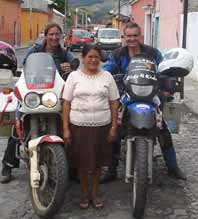
Albert
Hoermann, riding his Africa Twin, had decided to join me for awhile so we left
together the next day on our way to Monterrico, my last stop in Guatemala
before El Salvador. It was supposed to be a short ride as only 100 Km separate
Antigua to Monterrico but as it turned up it took nearly 5 hours. The reason
for the delay was a bus accident after no more than 10 Km into our ride. When
we got there, 30 minutes after the catastrophe, the road was still blocked.
One of the front tyres of the bus had exploded and the driver had lost the control
of it, the bus had then collided on the side of the road before rolling over.
There were 48 passengers on
Anyway, let me take a little rest before El Salvador, a country that I have
never visited before and I am looking forward to it.
Hasta pronto.
Click here to view more photos.
En
plein cœur du monde Maya.
Le
Guatemala a beaucoup souffert au fil des années avec les conquistadores,
les tremblements de terre et les révolutions. Maintenant, malgré
son histoire tragique et ses difficultés modernes, le Guatemala reste
un pays fascinant, très colorés et attachant.
Ce pays consiste principalement de montagnes couvertes de forêts de pin
et de forêts tropicales. Sa superficie est de 109,000 Km/carré.
A l'ouest, ou j'ai passé une bonne partie de mon temps, on y trouve plus
de 30 volcans donc beaucoup sont toujours actif. Les plus hauts atteignent 3,800m
de hauteur.
Guatemala a une population de 13 millions d'habitants dont 56% sont métis
et 44% des indiens. Si la population continue de croître à la même
vitesse (2,68% en ce moment) elle doublera d'ici l'année 2020.
Le café est la principale exportation, suivi du sucre, coton et bananes.
La religion prédominante est Catholique.

Samedi
4 Octobre 2003.
J'avais passé la nuit tout prés de la frontière et j'étais
assez confiant que le passage allait se dérouler sans problème.
A 7 heures du matin je faisais déjà la queue, pas de problème
pour avoir un tampon de sortie du Mexique dans mon passeport mais quand je présentais
mes papiers pour la moto à la douane ils me disaient que je devais retourner
à Tapachula (30 Km) de façon à avoir mon permis d'importation
annulé. Je devais absolument le faire sinon ils penseraient que ma moto
était restée au Mexique et comme ils avaient gardé le numéro
de ma carte bancaire comme garanti rien ne les empêcheraient de retirer
le montant nécessaire
pour
couvrir les taxes d'importation de ma moto. Cela ne me plaisait pas du tout
de devoir retourner sur mes pas et pour compliquer les choses il se mit à
pleuvoir aussitôt que je prenais la route. J'arrivais trempé au
bureau des douanes pour trouver la porte fermée. Effectivement, comme
c'était un Samedi, ils n'ouvraient qu'à 9 heures, il était
juste 8 heures. Eventuellement les choses ce sont arrangés, le soleil
est réapparu, j'ai séché et je pouvais enfin annuler mon
permis d'importation. De retour à la frontière il me fallait tout
refaire du coté du Guatemala. Cette fois pas de carte bancaire nécessaire
et je ne devais payer que 7 Euros de taxe. Ils insistaient à désinfecter
ma moto en l'aspergeant d'un produit, soit disant pour se protéger des
microbes du Mexique. Si le Guatemala était une île cela se comprendrait
mais cela n'est pas le cas. Je n'ai pas bien compris car rien n'empêche
les oiseaux, les mouches ou les moustiques de traverser la frontière
à moins que bien sur ces derniers savent lire et font demi-tour en voyant
la frontière, mais je n'y crois pas trop. Donc j'ai payé mes 2
Euros pour cette connerie et reprenais finalement la route vers 11 heures, comme
quoi il ne faut jamais être pressé quand il y a une frontière
à passer.
Je m'en allais à Panajachel, un petit village sur les bords du
lac Atitlan, à 300 Km plus au sud-est. C'est la région la
plus dramatique et impressionnante du Guatemala. Le long de la route j'étais
gâté avec des vues magnifiques et je pouvais voir des hommes, femmes
et enfants portant d'immenses fardeaux de bois sur leurs dos, certainement pour
se chauffer et pour faire la cuisine. Le temps était plus ou moins ensoleillé
malgré une bonne averse juste avant mon arrivée à Panajachel.
J'avais visité cette région deux fois auparavant mais j'étais
quand très excité d'y retourner. Le lac Atitlan est le restant
d'un volcan qui c'est effondré et qui c'est rempli d'eau. Avec une profondeur
maximal de 320m et recouvrant une superficie de 128 Km/carré il est entouré
de trois puissant volcans. Le volcan Atitlan est le plus haut à

3537m.
Ce jour là, c'était un jour de fête à Panajachel
et je me retrouvais entouré de gens dansant et faisant la fête
alors que j'essayais de trouver une place pour la nuit. Une procession religieuse
essayait aussi de trouver un chemin vers l'église alors que des pétards
explosaient de tout coté. J'ai finalement réussi à trouver
une petite pension très amicale pour passer quelques jours à ré
explorer la région.
Ma destination suivante était Antigua
(population 30,000 habitants), une des plus vieilles et plus belles villes
des Amériques. Ces rues pavées, ces maisons coloniales et ces
arbustes bougainvilliers arrosant les toits en font une ville très
charmante. Elle a été fondée en 1543 et fut la capitale
pendant 233 ans avant d'être complètement détruite par
un tremblement de terre en 1773. Elle a été lentement reconstruite,
gardant son caractère traditionnel, son architecture, et ces rues pavées.
En 1979, Unesco l'a déclaré un international héritage.
Je suis arrivé à Antigua vers 10 heures du matin (à seulement
100 Km de Panajachel) et j'ai rencontré Ariel, un gars du coin
très sympa qui lui aussi à une BMW. Il m'invita à rejoindre
le Guatemala BMW Club le Vendredi suivant pour un déjeuner et une balade
dans la région. En attendant je trouvais un petit hôtel pas cher
et je décidais de faire Antigua mon quartier général
au Guatemala.
Le jour suivant j'allais à Guatemala City, la capitale, pour rendre
visite au bureau national de World Vision avec l'intention d'organiser une
visite dans un de leur projet.
Guatemala City (population 2 millions) est la plus grande agglomération
urbaine en Amérique Central. Son énorme chaotique marché
explose d'odeur pas toujours attirante, de musique et de couleurs irréelle.
Des autobus, débordant de monde, sillonnent les rues dans un nuage
de fumée de diesel en essayant de trouver encore plus de passagers.
Tremblement de terre en 1917,1918 et 1976 l'ont secoué et détruite
plusieurs fois. Celui de1976 a fait 23,000 morts et en a blessé 75,000
en laissant plus d'un million sans abris. Guatemala City est aussi une ville
dangereuse et on y voit fréquemment des meurtres, des vols à
main armés et vols de voitures en plein jour. Il n'est pas du tout
recommandé de se promener seul le soir dans les rues. Voila pourquoi
j'ai choisi Antigua comme point de chute au Guatemala, en plus il n'y a que
45 Km entre les deux villes.
Vendredi 10 Octobre.
Comme entendu je suis allé rencontrer le Club BMW à 7,30 heures
au meilleur hôtel d'Antigua et j'étais accueilli par Arne
Snapper (importateur de BMW au Guatemala depuis 1958). Un petit déjeuner
grandiose nous était servi et je faisais connaissance de 14 motards
venus pour la balade. Je n'en revenais pas, des croissants, pâtisseries,
toutes sortes de fruit tropicaux, des omelettes au lard, céréales
et encore bien des choses nous étaient servi. Alors que je me tracassais
un peu pour l'addition, le président du club est venu me voir en me
disant que j'étais leur invité. J'en profitais bien sur pour
me remplir la panse au risque d'éclater.
Les motards avaient tous des grosses 1150cc et nous partions tous ensemble
vers 9 heures en direction de Panajachel mais cette fois ci sur des routes
secondaires et très agréables bien connu par les gens du coin.
C'était une matinée superbe, tous les volcans étaient
bien clairs, le ciel bien dégagé et le soleil nous faisait des
clins d'œil alors que nous sillonnions les routes. Nous nous sommes arrêtés
plusieurs fois pour prendre des photos. Nous sommes arrivés à

Panajachel
vers midi et ils m'ont conduit directement au meilleur restaurant pour déjeuner.
De nouveau un buffet campagnard nous y attendait (gratuit pour moi) et je faisais
très attention de ne pas trop remplir mon assiette mais je faisais quand
même plusieurs aller retour au buffet, particulièrement pour le
dessert. Les motards étaient en forme sur la route du retour et
je
devais me concentrer pour les suivre. Je les quittais vers 5 heures en leur
promettant de leur faire une soirée photos sur mon voyage au quartier
général de BMW à Guatemala City le Lundi suivant.
Je passais le Dimanche après midi à faire une révision
Général de ma moto, changement d'huile et de filtre à huile
et inspection général.
Deux
jours plus tard je décidais d'escalader Pacaya, un volcan actif
prés d'Antigua mais dormant en ce moment. Albert Hoermann, un
Autrichien voyageant en moto aussi mais seulement en Amérique Central,
me proposait de m'accompagner. Avec seulement 50 Km de route nous étions
prêt pour l'escalade à 8 heures du matin. Pacaya n'est pas populaire
qu'avec les touristes mais avec les voleurs aussi et il est recommandé
d'être accompagné par un garde ou par la police mais ce jour là
il y avait déjà des touristes qui escaladaient le volcan donc
en les suivant de loin nous étions en sécurité. Cela nous
a pris deux heures pour
atteindre
le sommet. La visibilité était plutôt nul tandis que la
fumée et les gaz sulfuriques qui sortaient du cratère nous piquaient
les yeux et la gorge. J'avais déjà visité ce volcan 10
ans plus tôt alors qu'il était en éruption, bien sur je
n'avais pas pu m'en approcher de si prêt mais le spectacle avait été
grandiose. Néanmoins, nous avons passé une excellente matinée
et étions de retour à Antigua en début d'après midi.
Comme promis, je faisais ma présentation chez BMW le Lundi soir. Comme
c'était un groupe de motards, mon exhibition était plus concentrée
sur le sujet moto, je leur parlais des pannes, des documents et des états
des routes entre autre. Tout le monde avait l'air ravi et nous terminions la
soirée avec des rafraîchissements offerts par le concessionnaire.
Mercredi 15 Octobre.
Ce matin là je quittais Antigua très tôt car j'avais rendez-vous
avec Daphne De Araneda au bureau national de World Vision à
8h30.
World Vision a débuté au Guatemala en 1975 et compte
à ce jour plus de 50,000 enfants parrainés. Beaucoup de projets
sont financés par les Etats-Unis et par le Canada mais aussi par l'Australie.
Généralement, quand j'arrive dans un nouveau pays, je reçois
beaucoup d'informations sur tous les projets dans ce pays mais pour des raisons
que je ne connais pas cela n'a pas été le cas pour le guatemala.
Ils m'ont emmenés brièvement visiter un projet près de
Guatemala City où j'ai pu rencontrer des enfants parrainés.
J'ai pu parlé avec eux et apprendre beaucoup de chose sur leurs vies,
par exemple ce qu'ils mangeaient au petit déjeuner, combien de Km devaient
ils marcher pour aller à l'école chaque matin et leurs rêves
pour l'avenir. Ce matin là ils participaient à un programme
où les plus grands leur apprenaient les résultats positifs d'une
bonne nutrition. Moi, de mon côté, je leur expliquais que j'étais
pâtissier et que je mangeais beaucoup trop de gâteaux et pas assez
de légumes ou de fruits.
Bien que j'ai passé une excellente matinée en leur compagnie,
je reste un peu déçu de ma visite car je m'attendais à
beaucoup plus.
Comme j'avais du temps de libre je suis passé chez BMW pour acheter
une ampoule de phare. Le fils du patron, Karl, avait remarqué
que mon pneu arrière commençait à être lisse, (je
l'avais monté en France et avais fait presque 20,000 Km) il insistait
pour m'en monter un neuf à ses frais. Comment pouvais-je refuser une
telle générosité? Muchas gracias Karl.
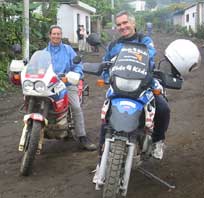
Albert
Hoermann, sur sa 750cc Africa Twin, avait décidé de m'accompagner
quelques jours et nous prenions la route le lendemain en direction de Montérrico,
ma dernière escale au Guatemala avant le El Salvador. Il n'y avait que
100 Km à parcourir entre Antigua et Montérrico mais ce qui aurait
du prendre 2 heures au maximum pris 5 heures. En effet, après 10 Km la
route était bloquée car un accident de bus venait juste d'avoir
lieu. Un des pneus avant du bus avait explosé et le chauffeur avait perdu
le contrôle du véhicule. Il y avait 48 passagers à bord,
2 étaient tués sur le coup et 22 blessés grièvement.
J'apprenais plus tard que le chauffeur avait pris la
compagnies
est énorme ce qui n'arrange rien car les patrons poussent les chauffeurs
à rouler très vite et à prendre à bord un maximum
de passagers dans des vieux bus qui ne passeraient aucun contrôle dans
nos pays. Cela a pris 3 heures pour dégager la voie et après avoir
finalement repris la route nous arrivions au petit village de La Avellana
vers 4 heures. De là, nous étions obligés de mettre les
motos sur une barque jusqu'à Montérrico, une traversée
de 15 minutes.
Montérrico est un petit village sur la côte Pacifique pas très
loin de la frontière de El Salvador. C'est très calme pendant
la semaine mais le village reprend vie le week end quand les guatémaltèques
viennent s'y reposés. Nous trouvions une pension et pour 3 Euros chacun
nous avions un petit bungalow avec toilette, douche à eau froide et un
ventilateur. Malheureusement, comme dans tous les pays tropicaux, les moustiques
nous attendaient, surtout le soir.
Bien que Montérrico apparaisse très calme et paisible il faut
quand même se méfier. Par exemple, une femme venant de El Salvador
et qui voulait immigrer aux Etats-Unis, me disait que quelqu'un lui avait vendu
un passeport Américain pour plus de 100 Euros (beaucoup d'argent au Guatemala)
mais celui-ci se révéla être faux donc inutile pour elle.
Je vais me reposer ici quelques jours avant d'affronter le El Salvador, un pays
que je n'ai jamais visité jusqu'alors mais qui me parait très
intéressant.
Hasta pronto.
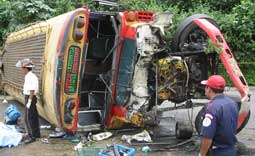
fuite
et que la police le recherchait. Des témoins disaient qu'il roulait très
vite et dans un état d'ivresse. Le problème au Guatemala et probablement
dans toute l'Amérique Centrale c'est que n'importe qui peut conduire
un bus, ils n'ont pas besoin d'expérience et peuvent acheter un permis
de conduire à 18 ans pour quelques Euros. En plus, tout les bus roulent
avec des pneus très usés et la police ne dit rien. La concurrence
entre les
Panajachel and Lago Atitlan.
Panajachel et le lac atitlan.
The beautiful city of Antigua.
La belle ville d'Antigua.
Market day in Antigua.
Le jour du marché à Antigua.
Sponsored children in Guatemala.
Des enfants parrainés au Guatemala.
Taking a break on our ride.
Moment de repos pendant notre promenade.
Tragic road accident.
Accident tragique de la route.
Getting to Monterrico on
the lancha.
En route vers Montérrico sur une barque.
Children in Guatemala.
Des enfants au Guatemala.
 |
 |
 |
 |
 |
 |
 |
 |
 |
 |
 |
 |
 |
|
JOURNAL 26.
21/10/03 . Guatemala. Total
mileage so far 52,055km .
(Pour la version française
du journal, allez au bas de la page ou cliquez
içi.
Pour revenir à la version française du site, cliquez
sur Français)
How
can you help make Ride4Kids a worthwhile project? To find out,
click here.
|
|




